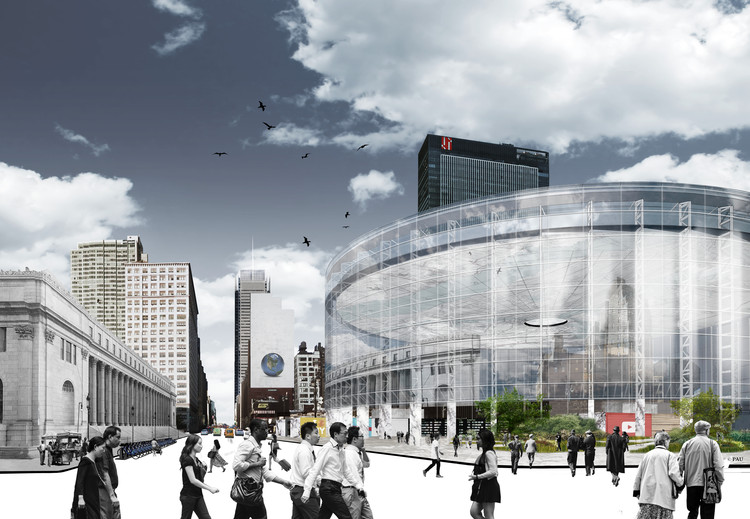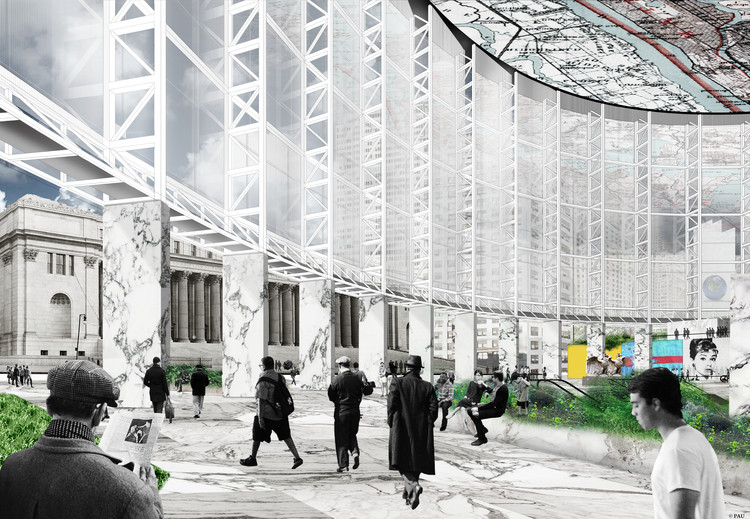
Last week, New York State Governor Andrew Cuomo announced a long-awaited and much-needed proposal for a makeover of Penn Station. Designed by SOM, the proposal for the new Penn Station–Farley Complex, to be completed in 2020, offers a pragmatic solution to the years of scrapped schemes and political stalling. However, The New York Times believes that Governor Cuomo’s proposal could be pushed further. The newspaper thus commissioned Vishaan Chakrabarti of PAU to come up with an alternative proposal to challenge Governor Cuomo’s plans.

Currently, Penn Station is buried underground beneath Madison Square Garden. It accommodates over 600,000 passengers per day, more than twice as many as JFK, La Guardia and Newark airports combined, yet the station remains unsafe and unpleasant to visit. Cuomo’s plan for the new Penn Station centers upon the construction of the Moynihan Train Hall, which will be built where the Farley Post Office Building currently stands. Chakrabarti raises the concern that the vast majority of the traffic will still take place under the Garden, as that is where people are funneled through, especially with the expected construction of the Gateway project which will add new platforms to the South of the existing platforms. Hence, the logic that the new monumental hall should be built across the street from the busiest area of Penn Station is, indeed, somewhat flawed.
The Gateway project, a new program to build rail tunnels under the Hudson River, means that there will be changes in the city skyline on the South end of Penn Station and the Madison Square Garden. Chakrabati notes that this provides Madison Square Garden with the possibility of selling the airspace they have there for new building developments, providing the funding required to move the arena elsewhere; more specifically, to the West end of the Farley building, just 800 meters away. This would leave the building that is currently housing the Madison Square Garden, and placed directly on top of Penn Station, conveniently empty. In the spirit of a shared civil society that “asks us to do more with less,” Chakrabarti advocates for the recycling of the building’s superstructure and foundations, as well reusing the original station’s mezzanine levels and balustrades. The result: Chakrabati’s Penn Station palimpsest, maintaining and displaying the rich and complex history of the site for its commuters.

Chakrabati’s vision for the building strips the structure of all its unsightly cladding, replacing it with a double layer of blast proof glass that will let light, but not heat, into the building. The structure of the station will allow for passive heating and cooling, making it possible to build a 25-foot (7.6 meter) high open entrance along the entire perimeter of the cylinder that will also offer clear and unobstructed exits in the case of an emergency. The suggested oculus in the ceiling allows for smoke to be expelled effectively in the event of a fire, making the building not only beautiful and pleasant, but also efficient and safe.

Connecting the transit station with its context is powerfully achieved with the enormous glass façade, as well as with the reimagining of the Garden’s ceiling into a map of New York, soaring at 153 feet (46.6 meters) above the heads of passengers exiting the trains. The circular roof also reinforces the local connection by alluding to other specific iconic structures in New York, such as the New York State World’s Fair pavilion and Pan Am’s “Worldport” building at JFK. Chakrabarti’s glass portal is therefore more than just a new station, or a new building; it is working to bind the fabric of the entire neighborhood, reimagining a future that is collective and common.

The original, grand Penn Station was completed in 1910, designed by McKim, Mead and White, and destroyed in the 1960s, despite protests and futile attempts at salvaging the elaborate structure. In its place, Madison Square Garden was built. Retrieving the site to house its initial function, while respecting the history that has accumulated in the intervening decades, is undeniably the ultimate celebration of the significance of Penn Station for the society of New York. Chakrabarti and PAU’s philosophy of doing more with less and aiming to create a monumental structure without a titanic public cost adds to this building’s identity as belonging to the people. One can only hope that Governor Cuomo’s administration sees its enormous potential.
You can see The New York Times' presentation of PAU's proposal here.
Correction update: An earlier version of this article claimed that under the SOM-designed proposal unveiled by Governor Cuomo, several platforms would be moved from their current position under Madison Square Garden to be below the new Moynihan Hall. This statement was incorrect and has been removed from the article.


































